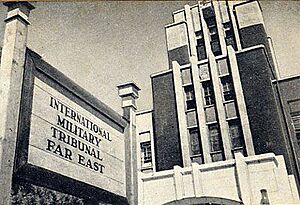International Military Tribunal for the Far East facts for kids
Quick facts for kids International Military Tribunal for the Far East |
|
|---|---|

Court chamber during the tribunal in Ichigaya, Tokyo
|
|
| Indictment | Conspiracy, crimes against peace, war crimes, crimes against humanity |
| Started | April 29, 1946 |
| Decided | December 12, 1948 |
| Defendant | 28 (see list) |
| Case history | |
| Related action(s) | Nuremberg trials |
| Court membership | |
| Judge(s) sitting | 11 (see list) |
The International Military Tribunal for the Far East (IMTFE), also known as the Tokyo Trial, was a special court held in Tokyo, Japan. It started on April 29, 1946. Its main purpose was to try leaders of the Empire of Japan for serious actions they took before and during World War II. These actions included planning aggressive wars, committing war crimes, and harming people.
The Tokyo Trial was set up like the Nuremberg trials in Germany. The Nuremberg trials had judged leaders of Nazi Germany for similar actions. After Japan lost the war and was occupied by the Allied forces, Douglas MacArthur, a United States General, created the IMTFE. A special document called a charter explained how the court would work. It also defined the types of actions that would be considered crimes.
Judges, prosecutors, and staff from eleven countries were part of the Tokyo Trial. These countries had fought against Japan. They included Australia, Canada, China, France, India, the Netherlands, New Zealand, the Philippines, the Soviet Union, the United Kingdom, and the United States. Both Japanese and American lawyers helped defend the accused.
The Tokyo Trial looked at actions that happened from the Japanese invasion of Manchuria in 1931. This was a longer period than the Nuremberg trials covered. Twenty-eight high-ranking Japanese military and political leaders were tried. These included former prime ministers, government officials, and military commanders. They faced many charges, such as starting aggressive wars and various war crimes. These crimes included cruel treatment of prisoners of war and civilians in occupied areas.
The Tokyo Trial lasted for more than two years, ending on November 12, 1948. It was much longer than the Nuremberg trials. Its decisions were very important for how international law developed. Similar international courts for war crimes were not created again until the 1990s. By the end of the trial, two defendants had passed away. One person was found unable to stand trial due to health reasons. All the other defendants were found guilty of at least one charge. Seven were sentenced to death, and sixteen were given life imprisonment.
Thousands of other people accused of lesser war crimes were tried by local courts. These courts were set up by Allied nations across Asia and the Pacific. Most of these trials finished by 1949.
Why Was the Tribunal Created?
The Tokyo Tribunal was created to make sure that agreements made during the war were followed. These agreements included the 1943 Cairo Declaration, the Potsdam Declaration, and the Japanese Instrument of Surrender. The Potsdam Declaration, from July 1945, said that "stern justice" would be given to all war criminals. This included those who had been cruel to prisoners. However, it did not specifically mention trials at that time.
The rules for the Tribunal were set out in the IMTFE Charter. This document was released on January 19, 1946. There was a lot of disagreement among the Allied countries about who should be tried and how. Despite these disagreements, General Douglas MacArthur decided to start arresting suspects. On September 11, just a week after Japan surrendered, he ordered the arrest of 39 people. Most of these were members of General Hideki Tōjō's wartime government.
How Was the Court Set Up?
On January 19, 1946, General MacArthur officially announced the creation of the International Military Tribunal for the Far East (IMTFE). On the same day, he also approved the Charter of the International Military Tribunal for the Far East (CIMTFE). This charter explained how the court would be formed. It also listed the types of crimes it would handle and how the court would operate. The rules of this charter were very similar to those used for the Nuremberg trials. On April 25, the official rules for how the Tokyo Tribunal would work were put into place.
See also
 In Spanish: Tribunal Penal Militar Internacional para el Lejano Oriente para niños
In Spanish: Tribunal Penal Militar Internacional para el Lejano Oriente para niños



